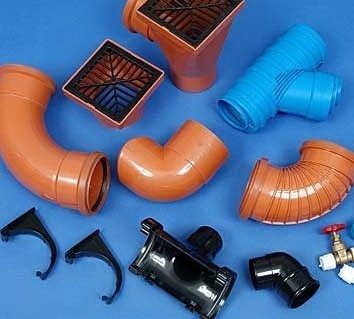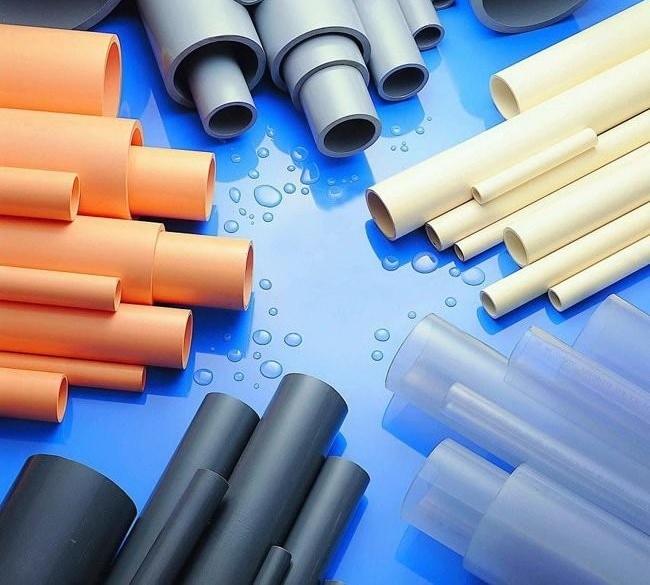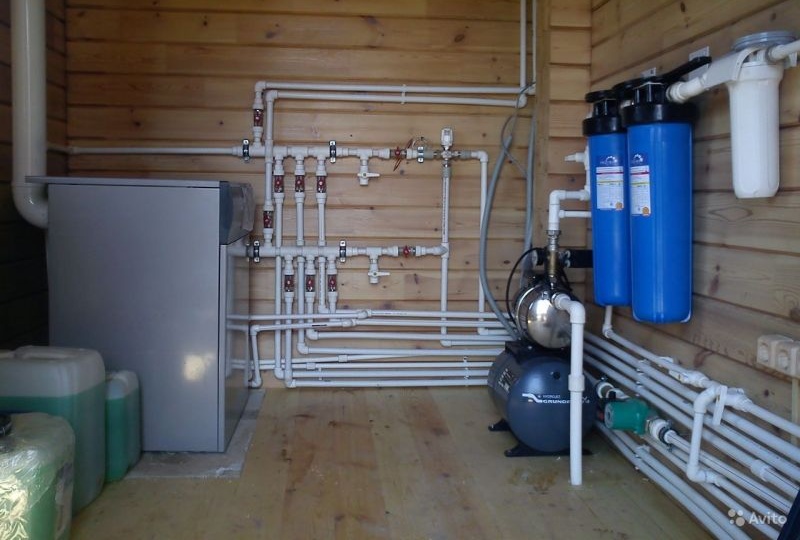How to choose polypropylene pipes for a competent heating system device
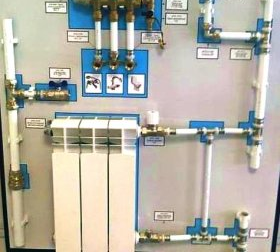
Heating systems, like any others, are not eternal. Sooner or later, the time comes to repair the structure or even simply replace it with a new one. Considering that the old systems have been in operation for more than a dozen years, a lot of time has passed since their installation and the owner who is going to buy new parts may simply not be aware of the whole variety of modern pipeline options. The materials that appeared relatively recently can significantly simplify installation and reduce the cost of the system as a whole. One of these options is polypropylene pipes for heating.
Content
Why is polypropylene better than other options?
Polypropylene - thermoplastic. This means that it changes physical properties during fluctuations in ambient temperature. At 140 ° C it begins to soften, while at 175 ° C it already melts. Thus, the operating temperature of any products made of polypropylene should not exceed 120 ° C. Typically, a lower temperature of about 95 ° C is indicated on the pipes as the maximum allowable.
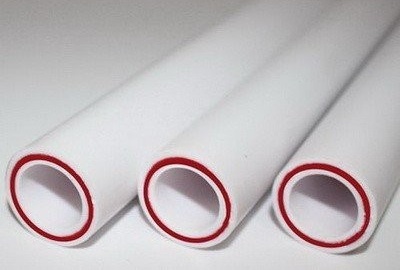
When buying pipes made of polypropylene, it must be borne in mind that they are made of thermoplastic, that is, a material that slightly changes its properties under the influence of high temperatures
The advantages of polypropylene pipes are obvious:
- The multilayer structure of the elements allows them to withstand fairly high temperatures.
- Simple installation procedure.
- Light weight, which simplifies the transportation and installation of parts.
- Pipes do not need to be painted.
- Easy to maintain.
- Environmental Safety. Under the influence of high temperatures, the material does not emit toxic substances.
- Low hydraulic resistance and complete absence of vibrations during the movement of the coolant through the pipes.
- No mineral deposits form inside the parts.
- Resistance to mechanical and chemical effects.
- The pipe does not conduct stray currents.
- Low cost.
- The service life exceeds 50 years.
- Welding connections compared to collet more durable, which extends the life of the system.
- High coefficient of thermal conductivity, respectively, heat loss in the system is minimal.
The coefficient of thermal expansion of polypropylene is quite high. According to calculations, a standard three-meter pipe with a temperature spread of 20 to 90 ° C is extended by three centimeters. This must be taken into account when arranging the system. In addition, it is necessary to know that at extremely low temperatures in the northern regions, the coolant in the heating system can be heated above the boiling point, which in combination with high pressure leads to pipe rupture.
Welding is the most reliable and popular way to connect polypropylene pipes, however, for this you need to choose a high-quality welding machine. The nuances that must be considered when buying it are discussed in the following article:https://aquatech.tomathouse.com/en/uchebnik/oborudovanie/svarochnyj-apparat-dlya-polipropilenovyx-trub.html
Thus, for regions where extremely low temperatures are possible, polypropylene is not recommended for operation in central heating systems. It is better to install stainless steel or galvanized steel parts. If autonomous heating, and the maximum temperature of the coolant is determined by the user, it is possible to mount polypropylene, since there can be no overheating of water in such systems.
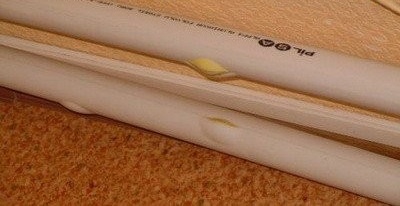
If the operating rules of pipes made of polypropylene are not observed, for example, at an excessively high coolant temperature or too high working pressure in the system, the parts may become deformed and collapse. With proper operation, they will last more than 50 years.
Classification of polypropylene pipes
The assortment of polypropylene pipes is represented by a large number of products. Distinguish single-layer and multi-layer elements. Single-layer parts are classified:
- PPH. The least durable models. Recommended for use in cold water supply systems, industrial pipelines and ventilation systems.
- RRV. Made from polymer blockomer. Used for the manufacture of shock high-strength connecting elements, as well as floor heating systems and pipelines with cold water.
- Ppr. It is made from random copolymer of polypropylene. It is recommended for creating pipelines for hot and cold water supply, as well as water heating systems, including floor varieties.
- PPS. It is made from highly inflammable high-strength polypropylene. It differs from other types of single-layer pipes with a higher value of maximum permissible temperature - 95 ° С.
Step-by-step instructions for installing heating using polypropylene pipes are presented here:https://aquatech.tomathouse.com/en/otoplenie/documents/montazh-otopleniya-iz-polipropilenovyx-trub.html
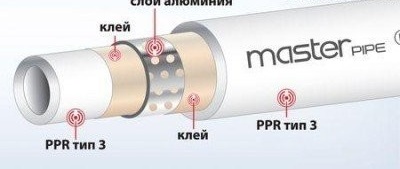
Polypropylene pipes can be reinforced with aluminum, either a continuous or perforated sheet of metal. Such products are characterized by greater tensile strength and lower coefficient of thermal expansion.
Multilayer pipes are also called reinforced. In addition to polypropylene, their composition also includes layers of various materials. Such products are divided into:
- Reinforced with perforated aluminum. It is made on the outer surface of the parts. Before welding, aluminum must be cut 1 mm.
- Reinforced with a solid sheet of aluminum. Metal is also applied to the outer surface of the element. When connecting parts, the aluminum layer is removed at a distance of 1 mm.
- Reinforced with aluminum sheet. It is carried out in the center of the product or closer to its inner part. Preliminary cleaning before welding of such pipes is not carried out.
- Fiberglass reinforced. The external and internal parts of the part are made of polypropylene, in the middle of the product is a layer of fiberglass.
- Reinforced with composite. As a composite, a mixture of fiberglass with polypropylene is used. The composition is laid in the middle of the element between the layers of polypropylene.
A clear advantage of reinforced products is a lower coefficient of thermal expansion, which allows them to lengthen less when heated. Despite this, the details during installation should not abut against walls or interior floors. If it is intended to be screed or plaster, be sure to leave free space for a possible extension. It must be understood that reinforcement reduces the level of thermal expansion, but does not completely eliminate it. Therefore, in some cases, it may be necessary to use special compensators.
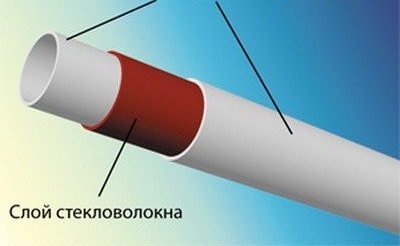
Unlike pipes reinforced with aluminum, parts reinforced with fiberglass are devoid of adhesive layers. Fiberglass is fused to polypropylene, so these products are not stratified during operation
In general, the technical characteristics and cost of such parts differ slightly.Pipes reinforced with aluminum need special pre-assembly preparation, which consists in stripping the metal layer. Whereas parts with fiberglass and composite can be welded immediately. The latter have one more advantage: they are not stratified during operation. This is due to the fact that in such pipes there are no adhesive layers, and the reinforcing material is fused into polypropylene.
Selection criteria - what to look for?
When choosing polypropylene pipes for a heating system, several important parameters must be taken into account.
Criterion # 1 - working pressure
Shows the maximum working long-term pressure at a temperature of 20 ° C, for which the pipe is designed. It must be indicated on the product label after the letters PN. For example, if there is a number 20 after the letters, this means that the product can operate at a pressure of 20 atmospheres. For heating systems, it is advisable to choose parts designed for 25 atmospheres, although 20 are also acceptable.
Of course, in some cases, the product will be able to withstand peak pressure values that exceed the maximum declared, but this is a short-term phenomenon. In addition, it must be remembered that when the temperature of the coolant in the pipe increases, the tensile strength decreases. This must be taken into account when choosing parts for the system.
Criterion # 2 - temperature
The product must indicate the maximum operating temperature of the coolant. This can be done in the form of markings with a clearly defined value, for example, “90C”. Or there should be an indication that the part is intended for transporting hot liquid.
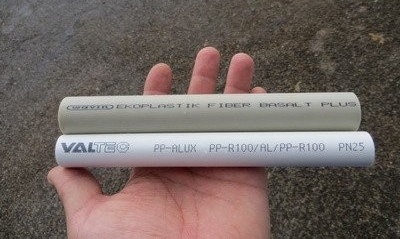
Polypropylene pipes for heating are supplied with a marking, which necessarily indicates the maximum allowable working pressure, coolant temperature, plastic composition, the presence and type of reinforcing material, and other important information
Criterion # 3 - Reinforcement
It is very desirable because it reduces the coefficient of thermal expansion of parts and increases their tensile strength. How to determine which is better, fiberglass or aluminum reinforcement? Experts say that in general, the parameters of the pipes are the same. It is worth paying attention to the manufacturer. If this is a well-known company, you can choose any option. If the product is unknown to the buyer of the manufacturer, it is better to prefer fiberglass or composite. Such details are more difficult to spoil, in any case they will last a long time.
Criterion # 4 - Diameter
The diameter of the pipes for the heating system is selected in accordance with the values obtained as a result of hydrodynamic calculations. Their goal is to pick up parts with the smallest possible diameter for various sections of the heating system. In this case, the general heating scheme, operating pressure and coolant temperature must be taken into account. In central heating systems, pipes with a diameter of 25 mm are usually used, whereas in autonomous systems this value can vary.
For floor heating designs apply parts whose diameter does not exceed 16 mm. In general, the diameter of polypropylene pipes is selected individually for each heating branch. The following nuances are taken into account:
- The internal section of the liner cannot be less than the internal section of the risers.
- The wall thickness of polypropylene pipes is greater than that of steel parts.
- For insertion of radiators into the wiring, elements with a diameter of 26 or 20 mm are usually used.

The photo shows polypropylene pipes for heating reinforced with aluminum and fiberglass. Their characteristics and cost are approximately the same. The advantage of a material with fiberglass is the absence of the need to clean parts before welding
Criterion # 5 - “Right” Manufacturers
As practice shows, for the arrangement of the heating system, pipes of German brands aquatherm GmbH, Rehau, Banninger and Wefatherm are most often preferred.Details from Czech manufacturers FV-Plast and Ecoplastik are also good. Democratic in price and quite worthy in quality option - Turkish pipes of Jakko, Firat, Vesbo, Pilsa, Kalde and TEBO brands. Among the Chinese parts, attention should be paid to Dizayn and Blue Ocean products. Among domestic manufacturers, products worthy of quality are offered by Politek, Santrade, Heisskraft, PRO AQUA and RVC.
For laying pipelines, polypropylene or metal-plastic pipes are most often purchased, a comparison of the technical characteristics of which is studied in detail in this material:https://aquatech.tomathouse.com/en/uchebnik/truby/polipropilenovye-ili-metalloplastikovye-truby.html
Fittings for polypropylene parts
Without properly selected fittings, it is impossible to create a polypropylene pipeline. They are responsible for the formation of turns, branches and turns of highways, as well as connect the various links of the pipeline. Together, a single system of the desired configuration is formed with extremely accurate docking of all elements. It is important to note that for pipes made of polypropylene can be used as ordinary fittings, which are mounted by diffusion welding, as well as elements with a special brass threaded insert, designed to connect not only plastic parts, but also metal structures.
The range of polypropylene fittings is very wide. Moreover, they differ not only in size. There are two types of such elements:
- Parts without thread.
- Fittings with threaded connections. They can be collapsible or integral.
A specific type of fitting is selected in accordance with its operating conditions. For example, hoses are more convenient to fasten with one-piece fittings, and the meter or tank is threaded.
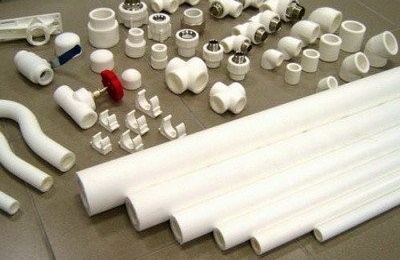
Fittings are necessarily used for the installation of a heating system from polypropylene pipes. They can be with or without threaded connections, intended for fastening by welding
Polypropylene pipes are an excellent replacement for traditional steel parts. They are not susceptible to corrosion, easier to install, durable, no scale deposits are deposited in them. However, it is not recommended to use such elements in conditions when the coolant may overheat. In addition, do not forget about a sufficiently high coefficient of thermal expansion, as a result of which it may be necessary to use special compensators for pipes. With the right choice of polypropylene parts, they will last without any problems for a very long time, delighting their owner with the warmth and comfort of the house.
